Every day in history class, students learn all about the men and women who have changed the world. But making a difference isn’t just for grown-ups. Here’s a selection of ten kids, past and present, who made history! You’ll find inventors, writers, activists, a composer, and more on this list! Will the next list of extraordinary kids feature someone that you know and love?
Jack Andraka
His breakthrough came to him while he was half-listening to his freshman biology teacher’s lecture on antibodies that bind protein to the blood. At the same time, he was secretly reading an article on carbon nanotubes in Science magazine. Jack wondered if he could create a network of nanotubes that could test a drop of a patient’s blood for the presence of pancreatic cancer. Seven months later, Jack’s test detected mesothelin (a protein that the body overproduces when pancreatic cancer attacks) in the blood of mice bearing pancreatic tumors. He won numerous awards for his groundbreaking work and was First Lady Michelle Obama’s personal guest at the 2013 State of the Union address.
Since then, Jack has published a memoir called Breakthrough: How One Teen Innovator is Changing the World and enrolled in Stanford University. In an interview with Laura Lane in MUSE Magazine, Jack advised students, “One thing I’ve learned is never give up, because you’re always going to be the greatest advocate for your research and ideas, so if you don’t believe in it, then who will?”

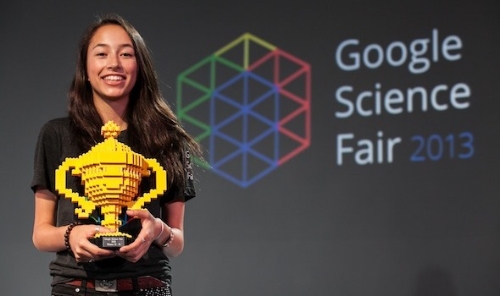
Ann Makosinski
Did you know that you have the power to light up a room right in the palm of your hand? Although this sounds like the plot of a sci-fi movie, Ann Makosinski made it a reality. At age 15, Ann invented a special flashlight after learning that a friend in the Philippines failed classes because she had no electricity and couldn’t study at night. It uses no batteries. It doesn’t rely on electricity, solar, or wind energy. The flashlight is powered only by the warmth of a human hand. And her invention could benefit 1.3 billion people—one-fifth of the world’s population—who don’t have regular access to electricity.
Ann has given three TEDx talks, was named one of Time magazine’s 30 under 30 for 2013, and appeared on The Tonight Show Starring Jimmy Fallon. Ann believes that when you have a problem, you should try to create a solution. “It might turn out to be someone else’s problem as well,” she says in an interview with Holly Bowne. “And you could end up helping a lot of people.” Read more about Ann and her invention.

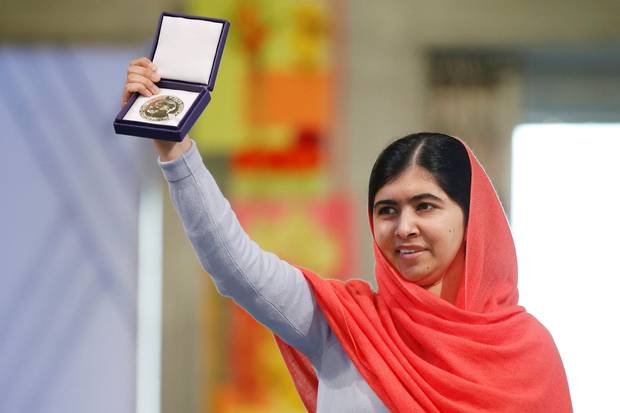
Malala Yousafzai
Malala Yousafzai didn’t plan on being an anonymous blogger. But when the Taliban threatened her right to learn, the safety of her friends and family, and her school, everything changed. In December 2008, the Taliban issued a demand—no girls shall go to school. A friend of her father’s at the BBC asked if there was a teacher or older student who would write a diary about life under the Taliban for its Urdu website. Nobody would do it.
Malala overheard her father and said, “Why not me?” Her blog became a success. She wrote about girls getting an education, her fear of the Taliban and the loss of her school, how much she loved learning, and her worry about her family and friends.
When her secret identity was revealed, though, Malala’s life became endangered. While 15-year-old Malala was on her way to school, a man in white robes boarded the bus shouting, “Who is Malala?” Then he fired three shots. Malala was shot in the head. After many surgeries, including being fitted with a titanium plate and a cochlear implant in her skull to help her recall, she made a full recovery.
After the shooting, more than two million people in Pakistan signed a petition titled “I am Malala” for the Right to Education campaign. She spoke to young people at the United Nations, became one of TIME’s most influential people of 2013, published an autobiography called I Am Malala, and started her own nonprofit fund to help girls around the world receive safe, free education. In 2014, Malala became the youngest person to ever receive the Nobel Peace Prize! Read more about Malala here in an article by Colette Weil Parrinello for FACES Magazine.


Anne Frank
Anne Frank, 13, knew her family was in danger. German soldiers had rounded up other Jews in Amsterdam and forced them onto trains to unknown destinations. No one returned. On July 5, 1942, Anne’s 16-year-old sister, Margot, received orders to transfer to a forced labor camp. Instead, the family immediately moved into a secret annex behind Mr. Frank’s office building, hidden behind a specially built bookcase.
For the next 25 months, they remained there, unable to go outside or open the curtains. Her father’s assistant, Miep Gies, and three others risked their lives to provide supplies to the Franks. Anne, who aspired to become a journalist, vividly recorded her experience in her diary. Then, on August 4, 1944, the door opened. A man was standing there with a gun in his hand. Anne and her family were arrested and, within a month, sent to Auschwitz concentration camp. Of the eight refugees, only Anne’s father survived. When World War II ended, he lived with Gies and her husband and he published Anne’s diary, as Anne had hoped to do herself.
The Diary of a Young Girl has been published in over 60 languages, has been adapted into a play and a movie, and is often regarded as one of the greatest books of the 20th century. Anne’s diary remains a classic and a window into one of the most horrifying periods of history. Discover the Anne Frank house in this article by Cynthia Levison from FACES Magazine.

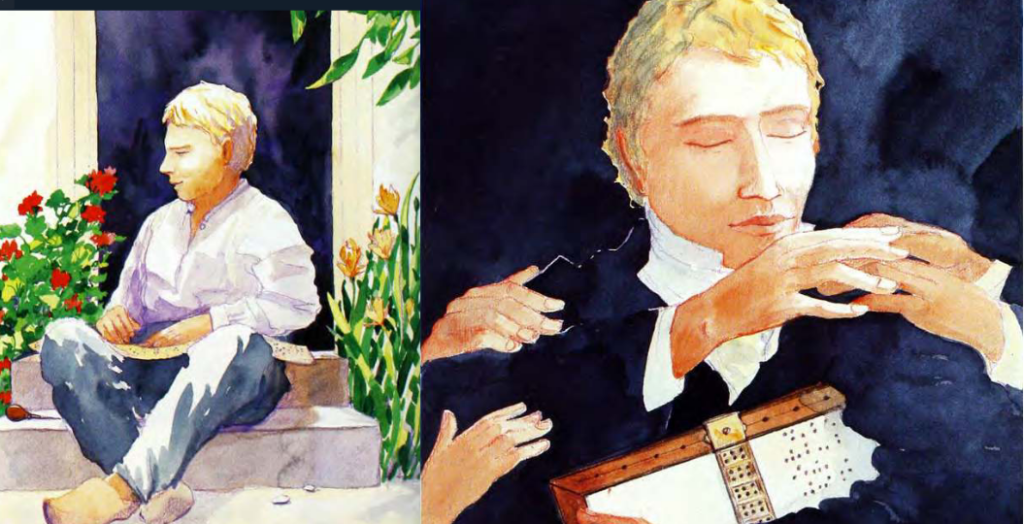
Louis Braille
How can you read if you cannot see? Thanks to Louis Braille, people who are blind can use their hands to read. Louis Braille was was born with sight in France in 1809. When he was almost four, he accidentally stabbed himself in the eye with an awl while playing in his father’s workshop. An infection spread to both eyes, leaving him blind. At that time, children with disabilities rarely received an education. But Louis’s parents were determined that their son would have an opportunity to learn and sent him to the Royal Institute for Blind Youth in Paris.
The school had 14 huge books with raised letters for students to read with their fingers. The letters had to be far apart to be clear and were so large that it took two hands to feel each letter. Louis knew there must be a better way.
A couple of years later, a French army captain, Charles Barbier, visited the school. Barbier had invented a way for soldiers on the battlefield to read their orders at night without a lamp. The system, called “night-writing,” used raised dots, each one representing one of the 36 sounds in spoken French. The teenaged Louis was particularly intrigued by Barbier’s idea and decided to improve it. Instead of using raised dots to represent sounds, he used them to stand for individual letters. He made each cell of dots small, so they could be read with one finger. His classmates loved his new system of reading and writing!
In 1854, France adopted the Braille system as the national standard. By 1879, Braille was spreading all over the world! Read this article about Louis in COBBLESTONE Magazine, written by Audrey DeAngelis and Gina DeAngelis.


Claudette Colvin
You’ve heard of Rosa Parks, but what about Claudette Colvin? On March 2, 1955, 15-year-old Claudette Colvin was arrested for refusing to give up her seat on a Montgomery, Alabama bus.
It seemed like any other day when Claudette and her friends got on the bus home. That is, until a white woman got on the packed bus and had nowhere to sit. The driver demanded that Claudette and her friends move to the back and stand, and while three of them did, Claudette stayed where she was. You’d think that would leave the white woman plenty of room to sit, but according to the laws of segregation, black and white customers could not share a row of seats. Claudette remembered thinking that she would have gotten up for an elderly person, but not a young woman.
She said, “Whenever people ask me: ‘Why didn’t you get up when the bus driver asked you?’ I say it felt as though Harriet Tubman’s hands were pushing me down on one shoulder and Sojourner Truth’s hands were pushing me down on the other shoulder.” Claudette was forced to stay in an adult jail until her mother arrived to bail her out.
Nine months later, Rosa Parks made newspapers around the world for her refusal to give up her seat. Soon, 40,000 African-American bus passengers began the Montgomery Bus Boycott. A year later, four of those activists testified before the US Supreme Court. Their goal? To convince the Supreme Court that city bus segregation was unconstitutional. One of those four plaintiffs was Claudette. Learn more about Claudette and other girls who fought for civil rights in COBBLESTONE Magazine.


Xiuhtezcatl Martinez
Xiuhtezcatl (pronounced SHU-tez-caat) Martinez is a teenager with big hopes for the Earth’s future. Since he was 6, he has dedicated his life to the fight for global environmental health. By age 13, he had received a presidential award for his work and was selected as one of the leading youth changemakers by the Campaign for a Presidential Youth Council. Xiuhtezcatl, whose name means “Turquoise Mirror,” has brought together youth from around the world to act as warriors defending our planet.
As the youth director for the Earth Guardians, an international organization of activists who work to create a sustainable future, Xiuhtezcatl leads kids and teens to take action and protect the Earth. In his work, Xiuhtezcatl has spoken to world leaders at United Nations assemblies around the globe, encouraging them to take steps against climate change. He is one of 21 kids who helped take the federal government of the United States to court for failing to do enough to stop climate change and harming the climate for future generations. He is also a hip-hop artist whose music also spreads an environmental message.
In an interview with Mara Johnson-Groh for MUSE, Xiuhtezcatl says, “I want to see a future where we can work out our issues with climate change as well as with each other. We need to respect the Earth and we also need to respect each other. I want to live in a world where politicians work for their communities, not their wallets. There is a lot of hate in the world right now, hate that leads to violence, racism, and crime. If we can just turn that hatred into love, our world would already be a better place.”

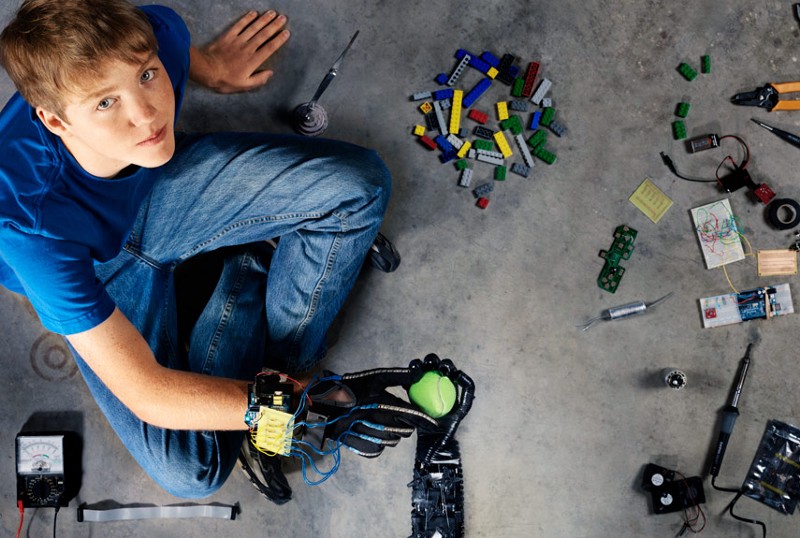
Easton LaChappelle
The arm on display dazzles viewers. It consists of 3D-printed plastic pieces with windshield-wiper motors to power its joints and knuckles. Brainwaves from an EEG (electroencephalography) headset control its movement. The user imagines giving a thumbs-up, and the limb obeys, curling the fingers into a fist while sprouting the thumb upwards. Wave, pitch a ball, grab and hold—the robotic arm proves very capable. Surprisingly, the arm was not forged in a glimmering laboratory by teams of brilliant scientists with millions of dollars to spend. Sixteen-year-old Easton LaChappelle designed, built, and programmed the invention, now on display at the 2012 Colorado State Science Fair.
When Easton learned that high-quality prosthetic arms often cost up to $100,000– compared to his $400 invention– he put all his energy into perfecting his inventions. He joined NASA’s Robonaut program and later launched his own company, Unlimited Tomorrow, to create affordable robotic prosthetics that work without surgery. Easton says, “We’re all born inventors. A lot of people think of inventing as something very technical, but I think inventing and creativity go hand in hand. Turning any kind of idea into reality is inventing. It could be through artwork or food or writing.”
Learn more about Easton in this article from MUSE Magazine, written by Jennifer Mason.


Wolfgang Amadeus Mozart
What were you doing when you were 4 years old? Were you playing with toys and watching cartoons on television? If you had been Wolfgang Amadeus Mozart, by the time you were 4, you would have been playing the harpsichord (an instrument similar to the piano). By 5, you would have been composing your own music and playing concerts for the kings and queens of Europe! Wolfgang was born more than 250 years ago, in Salzburg, Austria.
His father was a violinist and composer who quickly recognized his son’s gift. Herr Mozart took Wolfgang and his sister, Maria Anna (or “Nannerl,” on musical tours through Europe. The two children played for royalty and wealthy citizens, and Wolfgang Amadeus Mozart quickly became a household name. By the time he was 8, Wolfgang had written his first symphony. He wrote his first opera at he age of 12.
Today, Mozart’s music is very famous. It is played, performed, and enjoyed all around the world. Although he was only 35 years old when he died,Wolfgang had written more than 600 musical compositions. Chances are, you can hum a few bars of a Mozart tune– even if you don’t know who composed it! His amazing talent at a very young age forever changed the idea of what a child prodigy was. Even today, kids who show great talent in music want to be like Mozart, whose musical abilities made him one of the original “whiz kids.”
Learn more about Mozart in this article by Marcia Amidon Lusted.

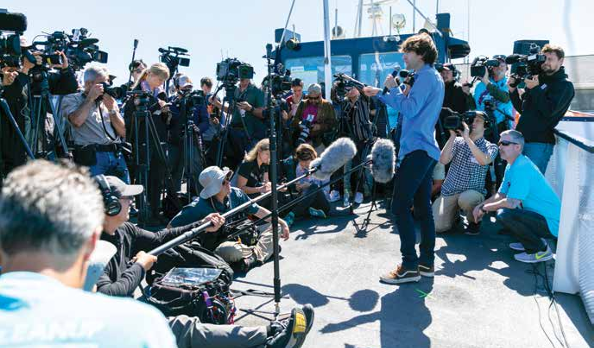
Boyan Slat
What to do about the confetti soup of plastics in our oceans? Enter 16-year-old Boyan Slat from the Netherlands. While scuba diving in Greece, he noticed more plastic than fish. After digging deeper into the world’s plastic pollution problem, Boyan was surprised to find that no one had made any serious attempts to tackle the issue.
The teen designed his high school science project around the problem. His research identified five major zones in the world’s oceans where the ocean’s currents converge (come together). These are often called “garbage patches.” The sun’s UV rays in these zones slowly breaks down plastics into microplastics. The “Boyan Wonder” quickly realized that cleaning the oceans using ships and nets would take thousands of years, cost billions of dollars, and harm sea life. Instead of going after the plastic, he creatde a “passive concentration system.” In this system, the ocean currents bring the plastic to him.
Boyan presented his idea at a TedEx conference in 2012, but his plan was not noticed by the scientific community. Then, six months after beginning studies to become an aerospace engineer, Boyan quite school and used 300 euros to start The Ocean Cleanup. Shortly after, his TEDx video went viral. His fortunes had begun to change. Five and a half years later, Boyan’s staff of over 70 engineers, researchers, and scientists designed a floating 2000-foot long barrier called System 001 to act as an artificial coastline and trap plastic. Boyan hopes to clean up half of the Great Ocean Garbage Patch by 2025!
Learn more about Boyan in Pat Betteley’s article from FACES Magazine.



